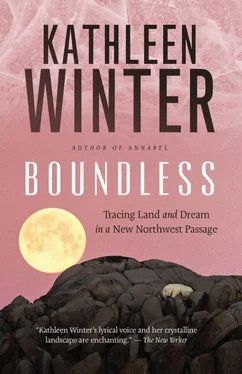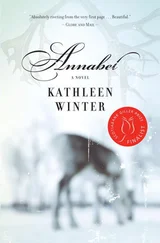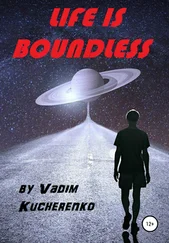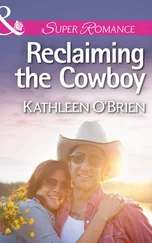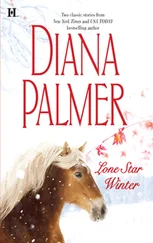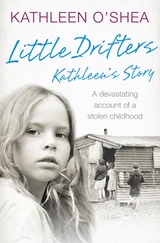On deck I told him I’d written a novel, Annabel , about a dual-gendered person.
“A person like that,” he said, “has a shamanic nature. Inuit pronouns have no gender. You don’t say here he comes, here she comes. You say here come those two . You have to listen to the shamanic world, and to dreams.”
I listened carefully. I wanted to learn as much as any other passenger did. On the land I relied on my solitude, my walking and observations, but I also gravitated toward Bernadette Dean and Aaju Peter because I wanted their Inuit and Greenlandic perspectives — wanted to hear what women of this land had to say, and was less interested in the old European male Arctic explorer stories to which the history buffs thrilled. I wanted to listen to the passengers as well, not to teach them but to learn from them, and I could do this by speeding up or slowing down on the paths, falling in with Gillian from England or Penny from Texas or world-wandering Gerald, who appeared to have no homeland apart from his battered shoes and his walking stick. I loved listening to their stories. I learned many had come to the Northwest Passage for healing. More than one woman had lost her life’s companion in the preceding year, and there’d been other losses, yearnings, personal tragedies, and transformations that had led people to this ship.
Nothing was solid. Paradox lay everywhere. Jean, whose husband had longed to make this journey but had died before they could embark, possessed great inner joy. Another woman, deep in pain over the recent loss of her life’s partner, was still somehow able to relieve others of physical sprains and aches by laying her healing hands on their injuries. I tended to follow and listen to the wandering souls, rather than those who knew the most facts about the land we were exploring.
But I also liked being alone. I picked my way up and down Sisimiut’s steep hills toward the whitewashed crosses of the graveyard, trying to stay apart, speaking only when spoken to, wanting the silent, unbroken gaze between myself and the town’s sled dogs to be the only communication. But it appeared I had a talkative companion.
“Crosses like the ones on those graves,” Nathan Rogers said, “are pre-Christian.”
“They are?”
I remembered hearing my mother, deep in her Jehovah’s Witness booklets, mutter about pagan crosses. But Nathan was harder to ignore. Like everything under the Greenland sun, he shone as if laundered, and he had such a genuine smile and such wild tattoos I almost forgot how he’d insulted my poor concertina.
“They signify the swords of fallen soldiers.”
“How do you know?”
“A degree in comparative religion sort of helps.” He proceeded to bring me up to date on the roots of Freemasonry and Mormonism.
“I had a friend,” I told him, “who let her basement apartment out to a couple of Mormons. She used to give them a raisin bun and tea every evening and they’d preach to her. Something about tablets of gold in the American woods, blazing with truth for the New World.”
“That’s right. Joseph Smith.”
“Anyway, they converted her. She became a Mormon missionary in Bucharest. But there’s something I’m dying to know.”
“What’s that?”
I hesitated. We had navigated higgledy-piggledy lanes. A church bell rang. Noon. A husky in the cove raised its snout and howled, a long, lonesome sound that twined and coiled and floated through the whitewashed crosses. We could no longer see the ship, or the main road, or the other passengers. I suddenly became afraid.
“Would we hear the ship’s horn if it blew?” The horn signified we were to get back on board and leave Sisimiut behind.
“Maybe. Is that the thing you were dying to know?”
“No. What I wanted to know is, what about the man, the naked man in the Bible, who — just as the disciples have fallen asleep and Judas is about to betray Jesus with a kiss — runs inexplicably through the Garden of Gethsemane? Nobody ever talks about him.” It was a question I asked anyone who professed to know anything about religion. Nobody had ever answered it; they hadn’t even tried. Not my mother; not my husband’s uncle, the Père blanc African missionary; and not my first husband, who had professed to know the New Testament better than he knew the Conception Bay Highway bus schedule. Those people all took one glance at that question and changed the subject.
“The naked man,” Nathan said, “was fulfilling a rite of a Dionysian cult.”
“He was?”
“It has to do with the Eastern Star. It has to do with mysteries hidden in plain view.” By the time Nathan elaborated we were at the summit of a tussock beyond which I saw that our ship was much farther away than I’d hoped.
“I wonder if I turned my tag,” I said.
Passengers leaving the ship each had a two-sided tag hanging on a hook and marked with their cabin number: green meant you were safely back on the ship, red meant you were not on board. If you’d forgotten to turn your tag to red as you left the ship, which was easy to forget at first, it appeared to all hands as if you might be having a nap in your cabin. It crossed my mind that this might afford an excellent way to get rid of a tiresome husband. But I knew, too, that the tags were not a game.
“Did you hear the story that some of the passengers were telling about a lost couple?” I asked Nathan. “They wandered too far on a coral reef during a southern expedition on another ship. Hours after that ship departed the reef, long after tides had washed the pair asunder, someone noticed they weren’t in the dining room.”
“Are you afraid that might happen to us?”
“I wouldn’t want to get left behind.”
“That won’t happen to us. Come on, we’ll get you back to the ship.” He started back down the confusing lanes and I realized he was very serious about reassuring me. “My father,” he explained, “died lifting passengers to safety.”
“On that Air Canada plane.”
“Flight 797. On June 2, 1983.”
“I know. He got stuck in the plane. I’m really sorry. You were what, only three or four years old?”
“He wasn’t stuck in the plane. He was at the exit, calling to passengers who couldn’t see for the smoke, telling them the way out, carrying them, throwing them to safety. If ever we have an accident on this ship, or anywhere, that’s the way I want to go. So don’t worry, we aren’t lost and you aren’t going to get left behind.”
We managed to hurry around a maze of little streets downhill and shoreward in time to duck into the village artists’ workshop before the last horn. Aaju Peter held the foot of an Arctic ptarmigan set in a chain. It was white, its feathers fluffy as fur, and Aaju looked at every part of it with tenderness.
“It was made in the town where I was born,” she said, “by a southern white woman. I have to buy it. Art has no colour.”
I felt something open inside me. I might have expected an Inuk woman to lay that ptarmigan foot down as soon as she realized a white woman had made it. In accepting the white artist’s work, Aaju made me feel that I, too, had a right to find my own truth on this voyage. Yes, I was a descendant of colonial Englishmen, and no, no one in my family had been born Canadian: in fact, I felt like a cultural orphan. But if Aaju was right, if art had no colour, maybe my perception, the raw material for my writing, also deserved to be treated by me with tenderness rather than self-doubt.
LATER, ON BOARD the ship, Nathan performed “The Northwest Passage.” His guitar was a beautiful, hand-made instrument, and to perform, Nathan had brought along stunning shirts embellished with magnificent Western and Celtic designs. His whole public persona took on a true musician’s extra wattage, and he introduced the song knowing full well how deeply it had settled into people’s ideas of what made this whole journey important. I wondered how it felt to share his father’s music when he had not had the chance to know Stan Rogers through any manner other than that of the lifeline of his songs. Singing them must have felt like both a public and a very private act, and I think many sons of lost, heroic fathers would never have been able to do it.
Читать дальше
